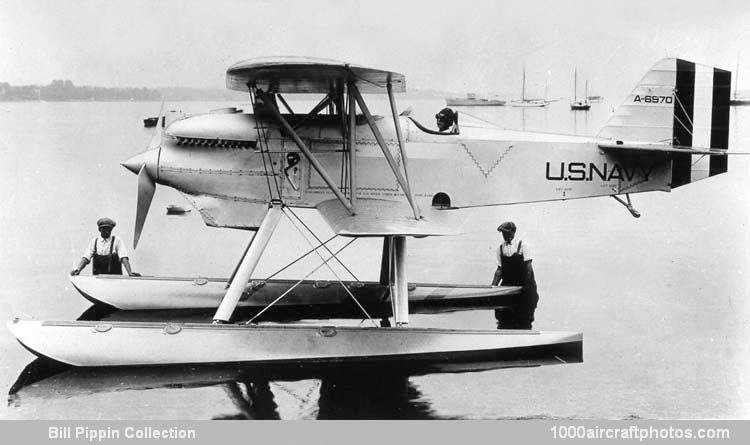12/29/2014. Remarks by Johan Visschedijk: "The F6C series started as a land-based fighter for the USMC that duplicated the US Army P-1, but subsequent engine changes and special Navy features made it considerably different from late P-1s. While this was the first Curtiss USN fighter after the F4C, it skipped the logical F5C designation at USN request because of the large number of F-5L flying boats still in service under their original designations. Reports that a USN version of the PW-8 with a radial engine was designated F5C cannot be verified. USN Hawks up to and including the F6C-3 could be fitted with twin floats.
F6C-1 (Model 34C). Nine F6C-1s, BuNos. A-6968 to A-6976, were ordered in March 1925. The first F6C-1 was delivered in August 1925, and the last four were converted to F6C-2 before delivery. The first F6C-1 was converted to the prototype F6C-4 and then to XF6C-5. Two others, A-6970 and A-6972 were converted to F6C-3; the final two served into 1932.
F6C-2 (Model 34D). The last four F6C-1s (A-6973 to A-6976) were modified at the factory with reinforced fuselages, deck arrester hooks, and new high-impact landing gears to suit them for carrier operations. Delivered in November 1925, the F6C-2s served until 1928.
F6C-3 (Model 34E). Improved version of the F6C-2 of which 35 (BuNos. A-7128 to A-7162) were delivered starting in January 1927. Originally, these had F6C-2 landing gears but in 1928 these were changed to a revised spreader-bar type introduced on the first production F6C-4. When operated as land-based fighters by the USMC, eight F6C-3s reverted to the F6C-1 type of landing gear. In 1928, Navy Squadron VB-1 operated its F6C-3s on floats. One cleaned-up F6C-3, BuNo. A-7147, won the Curtiss Marine Trophy for 1930 before being converted to the XF6C-6. Shortly afterward, in keeping with the new USN policy of using only air-cooled engined aircraft in the fleet, the F6C-3s were withdrawn from squadron service. In 1928, BuNo. A-7144 was modified extensively for racing by having the radiator installed inside the fuselage and a low-drag landing gear fitted. It was further refined in 1929 as the F6C-6.
XF6C-3. One F6C-3, BuNo. A-7136, was diverted to test work and given the X-for-Experimental prefix that the Navy adopted in 1927.
F6C-4 (Model 34H). After the first F6C-1 was converted to the F6C-4 prototype in 1926, 31 production examples were ordered (BuNos. A-7393 to A-7423). The first of these, featuring the nose spinner of the prototype, was delivered in February 1927, but the second and following did not come until nearly a year later. These did not have the spinner but had the redesigned spreader-bar landing gear of A-7393, and were withdrawn from squadron service in 1930 and sent to Pensacola as trainers.
XF6C-4. The first production F6C-4, BuNo. A-7393, was used for test work under the designation of XF6C-4.
XF6C-5. The first F6C-1, after conversion to F6C-4, was fitted with a 525 hp Pratt & Whitney R-1690 Hornet engine and production F6C-4 landing gear and redesignated XF6C-5.
F6C-6. This was F6C-3 BuNo. A-7144 modified for 1929 racing. After being placed fourth in the unlimited free-for-all race, it was reconverted to F6C-3 with F6C-4 landing gear but retained the rounded-out rear fuselage of its racing configuration.
XF6C-6. The winner of the 1930 Curtiss Marine Trophy, F6C-3 BuNo. A-7147, converted to a monoplane racer for the 1930 Thompson Trophy Race.
XF6C-7. One F6C-4, BuNo. A-7403, was converted at the Naval Aircraft Factory in 1932 to serve as a test bed for the new 350 hp Ranger SGV-770 twelve-cylinder air-cooled inverted V-engine. The F6C-4 designation on the rudder was not changed."
